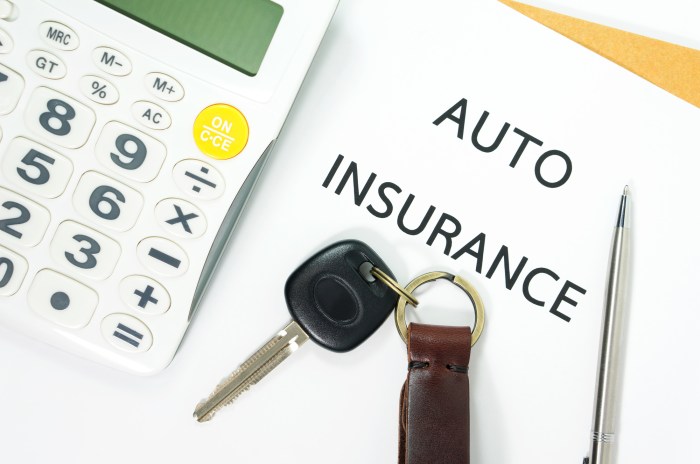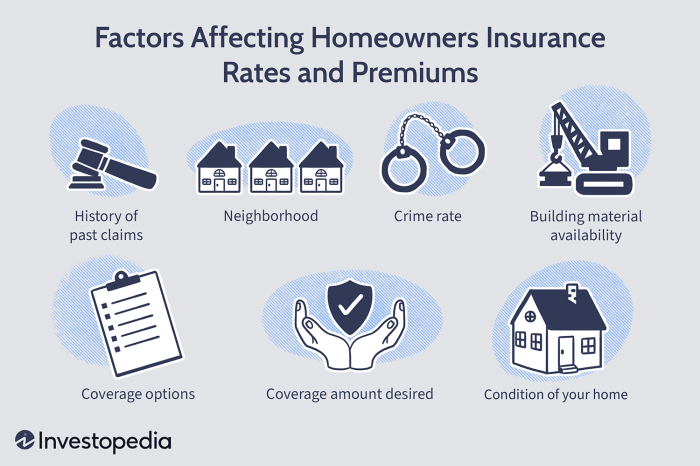Securing affordable auto insurance is a significant financial concern for many. Understanding the factors that influence premiums and employing effective strategies to reduce costs can lead to substantial savings over time. This guide delves into the key elements impacting your insurance rates, providing actionable steps to lower your premium and maintain financial stability.
From understanding the impact of your driving history and vehicle choice to exploring various discounts and insurance options, we will equip you with the knowledge to navigate the complexities of auto insurance and achieve significant cost reductions. We’ll examine both short-term tactics and long-term strategies for sustained savings.
Factors Influencing Auto Insurance Premiums

Understanding the factors that determine your auto insurance premium is crucial for securing the best possible rate. Several key elements contribute to the final cost, and awareness of these can help you make informed decisions. This section will delve into the most significant influences on your premium.
Driving History and Premium Costs
Your driving record is a primary factor in determining your insurance premium. A clean driving history typically results in lower premiums, while violations and accidents significantly increase costs. For instance, a speeding ticket might lead to a 10-20% increase, while a DUI conviction could result in a much higher percentage increase, or even policy cancellation. Similarly, at-fault accidents dramatically raise premiums due to the associated claims costs. The severity of the violation and the number of incidents within a specific timeframe are considered when calculating the premium. Multiple violations within a short period will generally lead to a more substantial premium increase than isolated incidents.
Age and Gender
Age and gender are statistically significant factors in insurance pricing. Younger drivers, particularly those under 25, generally pay higher premiums due to increased accident risk. Insurance companies have compiled data showing that this demographic has a statistically higher accident rate compared to older drivers. Gender also plays a role, although the impact varies by region and insurer. Historically, male drivers, particularly young males, have been associated with higher accident rates than female drivers. However, this gap is narrowing in many areas. While precise figures vary widely depending on location and the insurance company, it’s common to see a noticeable difference in premiums based on age and gender. For example, a 20-year-old male might pay significantly more than a 40-year-old female with a similar driving record.
Vehicle Type and Features
The type of vehicle you drive and its safety features heavily influence your insurance premium. Generally, higher-performance vehicles, sports cars, and luxury cars command higher premiums due to their higher repair costs and increased risk of theft. Conversely, smaller, more fuel-efficient cars often have lower premiums. Safety features such as anti-lock brakes (ABS), electronic stability control (ESC), and airbags significantly reduce the risk of accidents and injuries, leading to lower premiums. The presence of advanced driver-assistance systems (ADAS), like lane departure warnings and automatic emergency braking, also contributes to lower insurance costs.
| Model | Year | Estimated Premium | Safety Features |
|---|---|---|---|
| Honda Civic | 2023 | $1200 | ABS, ESC, Multiple Airbags |
| Toyota Camry | 2022 | $1300 | ABS, ESC, Multiple Airbags, Lane Departure Warning |
| Ford Mustang GT | 2023 | $1800 | ABS, ESC, Multiple Airbags |
| Tesla Model 3 | 2023 | $1500 | ABS, ESC, Multiple Airbags, Autopilot |
Location and Premiums
Your location significantly impacts your auto insurance premium. Insurance companies consider the accident rate, crime rate, and the frequency of severe weather events in your area.
- Urban Areas: Generally higher premiums due to increased traffic congestion, higher accident rates, and increased risk of theft.
- Rural Areas: Typically lower premiums due to lower traffic density, fewer accidents, and lower risk of theft.
Strategies for Reducing Auto Insurance Costs
Lowering your auto insurance premiums requires a multifaceted approach encompassing safe driving habits, strategic coverage selection, and smart shopping for insurance providers. By understanding the factors that influence your rates and implementing effective strategies, you can significantly reduce your annual costs.
Improving Driving Behavior to Lower Premiums
Safe driving habits are a cornerstone of lower insurance premiums. Insurance companies reward responsible drivers with discounted rates, reflecting the lower risk they represent. Implementing these practices can lead to significant savings over time.
- Maintain a clean driving record: Avoid accidents and traffic violations. A single accident or speeding ticket can substantially increase your premiums for several years.
- Practice defensive driving: Anticipate the actions of other drivers and react appropriately. This includes maintaining a safe following distance, yielding to other vehicles, and avoiding distractions such as cell phone use.
- Complete a defensive driving course: Many insurance companies offer discounts for completing approved defensive driving courses. These courses teach safe driving techniques and can help you become a more responsible driver.
- Install anti-theft devices: Adding anti-theft devices to your vehicle, such as an alarm system or immobilizer, can reduce your premiums by demonstrating a lower risk of theft.
Comparison of Auto Insurance Coverage and Cost Impact
Different types of auto insurance coverage offer varying levels of protection and consequently, affect your premium. Understanding these differences is crucial for choosing the right coverage at the most affordable price.
| Coverage Type | Description | Cost Impact | Recommended Usage |
|---|---|---|---|
| Liability Coverage | Covers bodily injury and property damage to others caused by an accident you are at fault for. | High (mandatory in most states) | Essential; choose limits appropriate to your risk tolerance and assets. |
| Collision Coverage | Covers damage to your vehicle regardless of fault. | Moderate to High | Recommended for newer vehicles or those with significant loan balances. |
| Comprehensive Coverage | Covers damage to your vehicle from non-collision events, such as theft, vandalism, or weather damage. | Moderate | Recommended for newer vehicles or those with significant loan balances. |
| Uninsured/Underinsured Motorist Coverage | Protects you in case you’re involved in an accident with an uninsured or underinsured driver. | Moderate | Highly recommended, as it provides critical protection in a common scenario. |
| Medical Payments Coverage (Med-Pay) | Covers medical expenses for you and your passengers, regardless of fault. | Low to Moderate | Useful supplementary coverage, especially if your health insurance has limitations. |
Finding Affordable Insurance Providers
Shopping around for auto insurance is crucial to finding the best rates. Several resources can help you compare quotes and find competitive pricing.
- Online comparison websites: Websites like The Zebra, NerdWallet, and Insurify allow you to compare quotes from multiple insurers simultaneously.
- Directly contacting insurance companies: Contacting insurers directly allows for personalized quotes and the opportunity to discuss specific needs and discounts.
- Working with an independent insurance agent: An independent agent can compare quotes from various companies, saving you the time and effort of contacting each one individually.
Benefits of Bundling Insurance Policies
Bundling your home and auto insurance policies with the same provider often results in significant savings. Insurers frequently offer discounts for bundling, rewarding customer loyalty and simplifying their administrative processes.
Bundling can often result in a 10-20% discount on your overall premiums, depending on the insurer and your specific policies.
For example, a driver paying $1200 annually for auto insurance and $800 annually for homeowners insurance might receive a 15% discount when bundling, saving them $300 annually ($1200 + $800 = $2000; 15% of $2000 = $300). This demonstrates the potential for substantial savings through bundling.
Long-Term Strategies for Lower Premiums

Adopting a long-term perspective on auto insurance can lead to significant savings and financial stability. By consistently employing smart strategies, you can substantially reduce your premiums over time and protect your financial well-being. This involves more than just finding the cheapest policy for the current year; it’s about building a history of responsible driving and financial management that insurers reward.
Maintaining a Clean Driving Record
A clean driving record is the cornerstone of lower insurance premiums. Each accident-free year contributes to a lower risk profile in the eyes of insurance companies, resulting in progressively lower premiums. Imagine a graph charting premium costs over time. The initial premium might be relatively high. However, with each year of safe driving, the line representing the premium steadily descends, creating a noticeable downward slope. After five years of accident-free driving, the premium might be significantly lower than the initial cost. After ten years, the reduction becomes even more substantial, demonstrating the cumulative benefit of consistent safe driving. This visual representation illustrates how a long-term commitment to safe driving translates into substantial cost savings over the years.
Selecting Appropriate Insurance Coverage Over Time
Insurance needs evolve alongside life changes. A young driver with a basic car might need minimal liability coverage, but as responsibilities increase—purchasing a new home, having children, or acquiring more valuable assets—the need for higher coverage levels (such as comprehensive and collision) becomes apparent. Similarly, as a driver ages and their driving habits change, they may reassess their coverage requirements. For example, someone retiring and driving less might consider reducing their coverage levels, thus lowering their premiums. Regularly reviewing and adjusting your coverage based on your current life circumstances ensures you have the right protection without overspending on unnecessary coverage.
Consistent On-Time Premium Payments
Consistently paying premiums on time demonstrates financial responsibility, a key factor considered by insurance companies. Late or missed payments can negatively impact your credit score and lead to higher premiums. Conversely, a history of on-time payments can improve your credit score and demonstrate reliability, potentially leading to discounts or favorable rate adjustments from insurers. This long-term commitment to financial responsibility translates to cost savings and improved creditworthiness.
Hypothetical Five-Year Savings Scenario
Let’s consider a hypothetical scenario. Sarah initially pays $1200 annually for auto insurance. By implementing several strategies—maintaining a clean driving record, bundling home and auto insurance, opting for a higher deductible, and paying premiums on time—she achieves a 5% annual reduction in her premium. Over five years, her annual premium would decrease as follows: Year 1: $1200; Year 2: $1140; Year 3: $1083; Year 4: $1029; Year 5: $977. This results in a cumulative saving of $1073 over the five-year period, demonstrating the power of long-term strategic planning. This scenario illustrates the significant potential for cost savings through consistent application of these strategies.
Epilogue

Ultimately, lowering your auto insurance premium involves a multifaceted approach encompassing responsible driving, smart insurance choices, and proactive financial planning. By understanding the factors influencing your rates and implementing the strategies Artikeld above, you can significantly reduce your insurance costs and allocate your finances more effectively. Remember, consistent diligence and informed decision-making are key to long-term savings.
Question & Answer Hub
How often can I get my insurance rates reviewed?
Most insurers allow for annual reviews, or even more frequently if your circumstances change significantly (e.g., new car, change in address, improved driving record).
Can I get my insurance canceled if I have a minor accident?
Not necessarily. Most insurers will consider a single minor accident without injury or significant property damage as a single incident and adjust your premiums accordingly, rather than canceling your policy.
What is the difference between liability and collision coverage?
Liability covers damages you cause to others, while collision covers damages to your own vehicle, regardless of fault. Both are important, but the level of coverage depends on your individual needs and risk tolerance.
How does my credit score affect my insurance premium?
Many insurers use credit scores as a factor in determining premiums. A higher credit score often translates to lower premiums, reflecting a perceived lower risk.